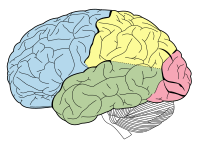
Photo from wikipedia
Objective: Based on the acoustoelectric (AE) effect, transcranial acoustoelectric brain imaging (tABI) is of potential for brain functional imaging with high temporal and spatial resolution. With nonlinear and non-steady-state, brain… Click to show full abstract
Objective: Based on the acoustoelectric (AE) effect, transcranial acoustoelectric brain imaging (tABI) is of potential for brain functional imaging with high temporal and spatial resolution. With nonlinear and non-steady-state, brain electrical signal is microvolt level which makes the development of tABI more difficult. This study demonstrates for the first time in vivo tABI of different steady-state visual stimulation paradigms. Method: To obtain different brain activation maps, we designed three steady-state visual stimulation paradigms, including binocular, left eye and right eye stimulations. Then, tABI was implemented with one fixed recording electrode. And, based on decoded signal power spectrum (tABI-power) and correlation coefficient between steady-state visual evoked potential (SSVEP) and decoded signal (tABI-cc) respectively, two imaging methods were investigated. To quantitatively evaluate tABI spatial resolution performance, ECoG was implemented at the same time. Finally, we explored the performance of tABI transient imaging. Results: Decoded AE signal of activation region is consistent with SSVEP in both time and frequency domains, while that of the nonactivated region is noise. Besides, with transcranial measurement, tABI has a millimeter-level spatial resolution (< 3mm). Meanwhile, it can achieve millisecond-level (125ms) transient brain activity imaging. Conclusion: Experiment results validate tABI can realize brain functional imaging under complex paradigms and is expected to develop into a brain functional imaging method with high spatiotemporal resolution.
Journal Title: IEEE Transactions on Neural Systems and Rehabilitation Engineering
Year Published: 2022
Link to full text (if available)
Share on Social Media: Sign Up to like & get
recommendations!